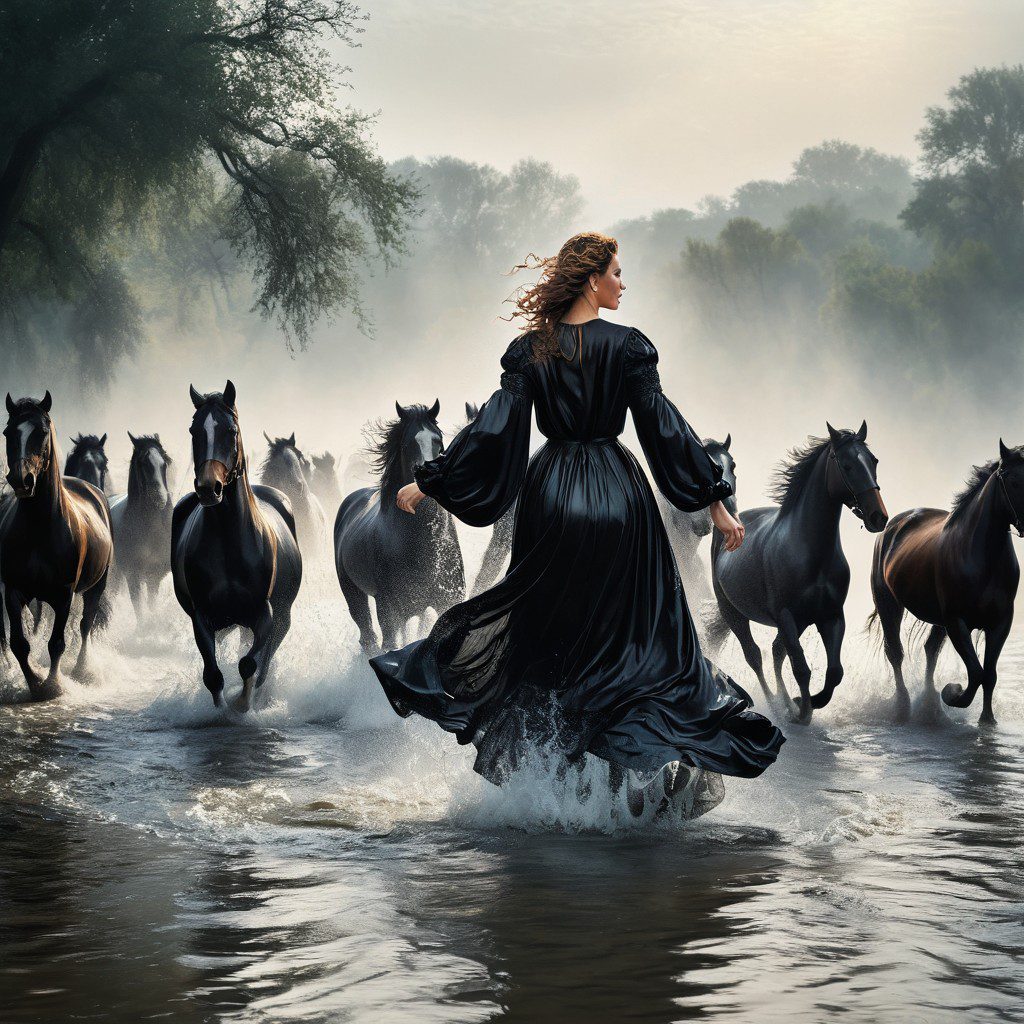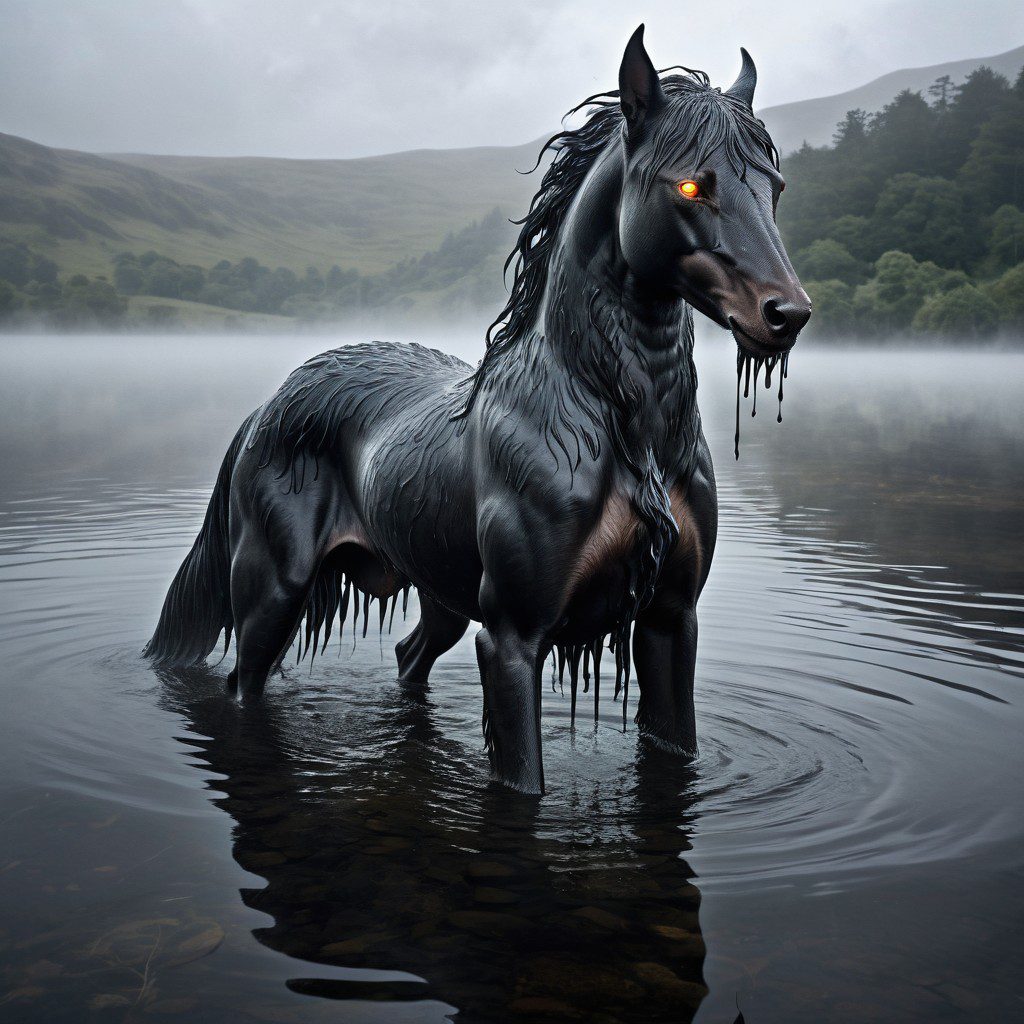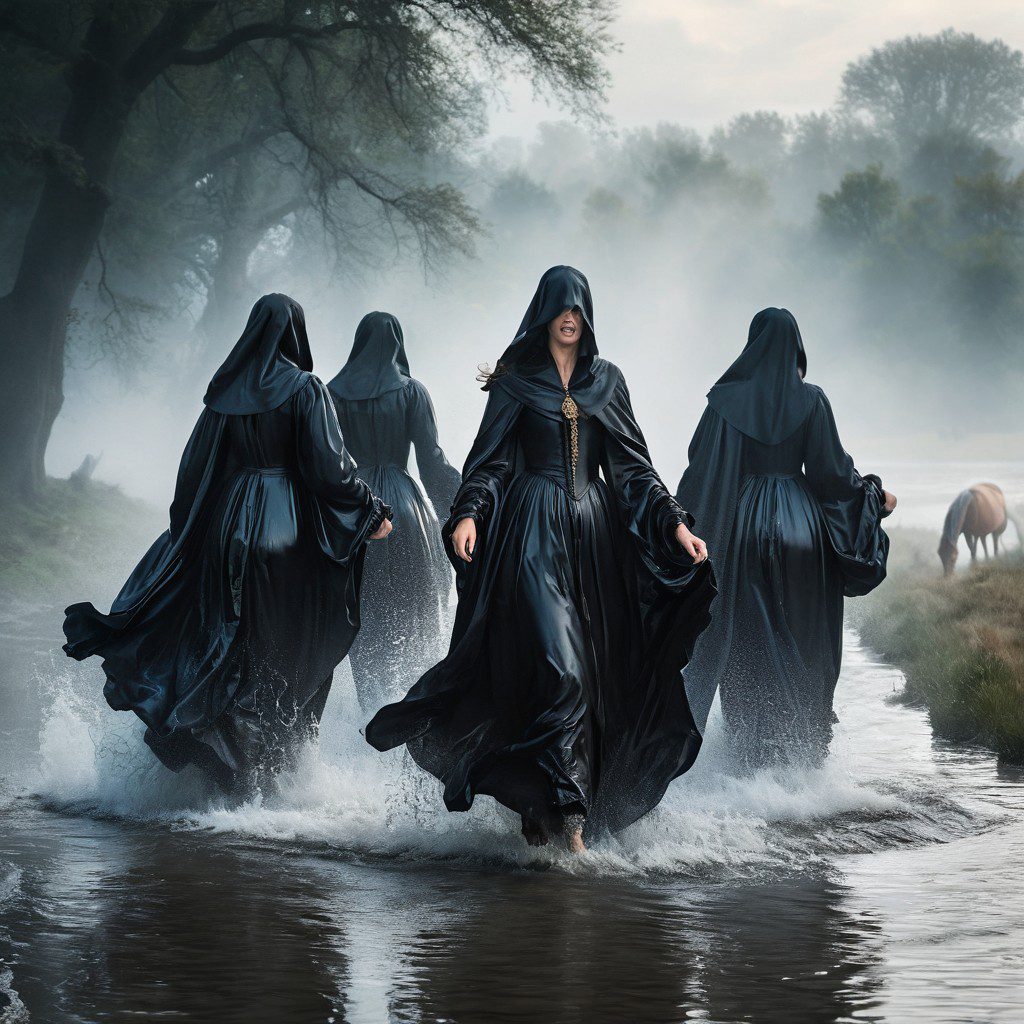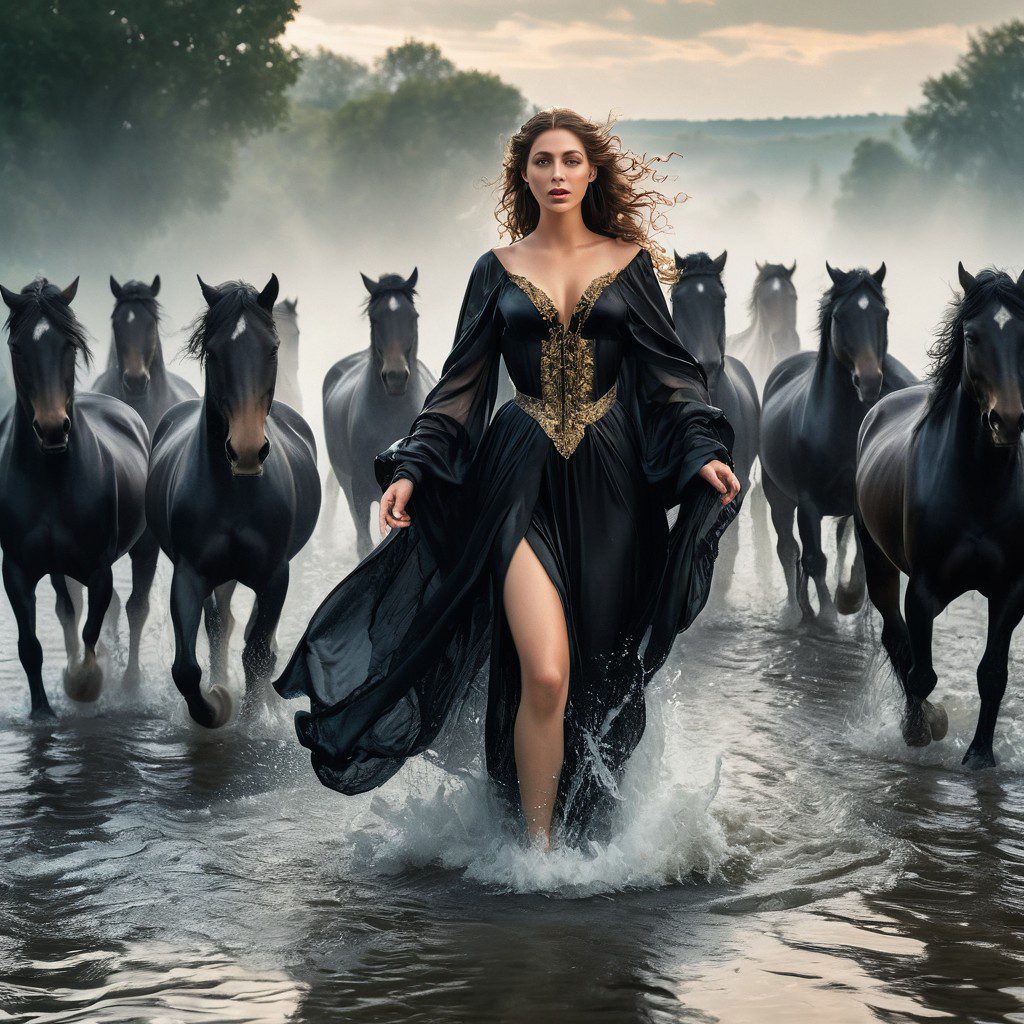Kelpie: The Shape-Shifting Water Horse of Celtic Lore

When it comes to myths of mysterious creatures lurking beneath the surface of deep waters, the kelpie stands out as one of the most chilling and enigmatic. Originating in the folklore of Scotland, the kelpie is a shape-shifting water spirit that is as fascinating as it is terrifying. Known primarily as a horse that lures unsuspecting humans to their doom, the kelpie embodies the treacherous beauty and danger of Scotland’s lochs and rivers. Yet, like all great mythological figures, the kelpie’s story is more than just a simple tale of predatory spirits—it’s a reflection of the untamed power of nature, the thin line between the mundane and the magical, and humanity’s eternal struggle to understand and survive the forces around it.
In this post, we’ll explore the origins of the kelpie, its appearances in classic tales, and its evolution into a fixture of modern media. Along the way, we’ll dissect its strengths and weaknesses, because even the most fearsome water spirits have their vulnerabilities.
Origins of the Kelpie: A Creature of Water and Deception
Kelpies are most commonly associated with the rivers and lochs of Scotland, especially the cold and remote waters of the Highlands. The word “kelpie” is believed to derive from the Scottish Gaelic cailpeach or colpach, meaning “heifer” or “colt,” which reflects its equine form. While the kelpie can appear in human guise, it is most often described as a beautiful black horse, drenched with water, that lingers near the water’s edge.
The kelpie’s defining trait is its power to lure people—particularly children—onto its back. Once a victim climbs aboard, they become magically stuck to the creature. The kelpie then plunges into the water, dragging its rider beneath the surface to drown them. This brutal aspect of the myth likely served as a cautionary tale, warning children and travelers to avoid the dangers of deep, unpredictable waters.
But the kelpie isn’t just a one-dimensional monster. In some stories, it’s a trickster, enjoying the chaos it causes. In others, it embodies a natural force—powerful, unpredictable, and indifferent to human life. Some versions of the myth suggest that the kelpie can take human form, often appearing as a handsome young man or a beautiful woman to lure people to the water. In these tales, the kelpie’s true nature is only revealed when its human guise slips, often betrayed by telltale signs like waterweed in its hair or hooves instead of feet.
The Kelpie in Classic Tales: A Monster in the Waters


Kelpies appear in a variety of stories across Scotland, though the most famous tales often focus on their predatory nature. One particularly common legend involves a kelpie pretending to be a tame horse, tempting weary travelers to ride it. Once the victim mounts, they are stuck fast, unable to dismount as the kelpie rushes into the loch. In a grimmer variation, the kelpie invites multiple children onto its back, growing longer to accommodate them all, only for their hands to become stuck. The water horse then drowns them, and their remains are found the next day, floating on the loch’s surface or washed up on the shore.
Despite its malevolent tendencies, the kelpie isn’t invincible. In some stories, humans outwit the creature or take control of it by stealing its bridle. The bridle is a powerful symbol in kelpie lore—it holds the creature’s supernatural power, and without it, the kelpie is as vulnerable as a regular horse. Some stories tell of brave individuals who manage to capture the bridle, forcing the kelpie into servitude. There are even tales of blacksmiths who forge iron horseshoes for the creature, rendering it harmless or banishing it from the human realm entirely.
These stories often mix horror with cleverness, suggesting that while the kelpie is dangerous, it can be defeated or at least controlled by those who are cunning and brave.
The Symbolism of the Kelpie: Nature, Danger, and the Uncontrollable


In many ways, the kelpie reflects the awe-inspiring and often dangerous power of water in Scottish life. With countless lochs, rivers, and rugged coastlines, water has always been a vital yet perilous part of the landscape. The kelpie embodies the dual nature of these waters—they can be beautiful and alluring but also deadly. The myths served as reminders to respect the dangers lurking in nature, especially bodies of water that may seem calm and inviting but hide treacherous currents and hidden depths.
Moreover, the kelpie’s ability to shape-shift and deceive reflects the unpredictable and uncontrollable aspects of the natural world. Kelpies are creatures of transition, inhabiting the boundary between the seen and unseen, the human and the supernatural. Their appearance as a horse, an animal so vital to human life in the past, but with malevolent intent, plays on this tension between trust and betrayal.
Kelpies in Modern Media: From Folklore to Pop Culture
The kelpie’s unsettling charm has made it a favorite in modern literature, art, and film. Its appearances often maintain the creature’s dark and mysterious origins while reimagining it in new contexts.
In J.K. Rowling’s Harry Potter series, kelpies make an appearance as one of the many magical creatures studied by students at Hogwarts. The creature’s water-dwelling, shape-shifting nature remains central to its characterization, though its danger is somewhat toned down compared to the original folklore.
More prominently, the kelpie has inspired contemporary artists and creators. One of the most famous modern depictions of kelpies is The Kelpies, a massive pair of 30-meter-high steel horse head sculptures by artist Andy Scott. Located in Falkirk, Scotland, these sculptures evoke the powerful mythic presence of the kelpie while celebrating the horse’s role in Scottish history and industry. Though not explicitly about the deadly aspects of kelpies, these towering works of art remind viewers of the mythical connection between horses and the Scottish landscape.
In the world of fantasy literature, kelpies often show up in darker, more horror-inspired settings. In Maggie Stiefvater’s The Scorpio Races, for instance, water horses, clearly inspired by kelpie lore, are central to the story. These creatures are both magnificent and deadly, echoing the fearsome beauty of their mythological counterparts.
Video games, too, have drawn on the kelpie myth, particularly in games that explore Celtic or Scottish themes. The Witcher 3: Wild Hunt includes references to kelpie-like water creatures, while other fantasy games such as The Elder Scrolls series have drawn on the idea of supernatural water horses in creating their own monstrous bestiary.
Strengths of the Kelpie
- Shape-Shifting Ability: The kelpie’s ability to transform into a human or a horse makes it a master of deception. It can lure victims with its beauty or charm, and in its equine form, it appears harmless until it strikes.
- Power Over Water: As a water spirit, the kelpie commands the waters it inhabits. This allows it to drown its victims with ease, pulling them into the depths where few can escape.
- Immense Physical Strength: The kelpie, even in its horse form, possesses incredible strength, allowing it to overpower most humans with ease.
- Bridle Magic: The kelpie’s bridle is key to its power. If it controls the bridle, the kelpie can command great magical abilities. However, if a human gains control of it, the kelpie can be enslaved or neutralized.
Weaknesses of the Kelpie
- Vulnerable Without Its Bridle: The kelpie’s magical abilities are closely tied to its bridle. If a human can steal or seize the bridle, they can control or even defeat the kelpie, turning the tables on this dangerous predator.
- Susceptible to Iron: Like many other supernatural creatures in Celtic folklore, kelpies are said to have a weakness to iron. In some tales, blacksmiths forge iron shoes for kelpies, preventing them from returning to their watery homes.
- Deceptive, But Can Be Outsmarted: While the kelpie is a master of deception, its tricks are not unbeatable. Humans who are clever enough to see through its guises or who recognize the warning signs (like wet hair or hooves in human form) can avoid its deadly clutches.
Conclusion: The Dark Beauty of the Kelpie
The kelpie remains one of the most intriguing figures in Celtic folklore. As a shape-shifting water horse, it embodies the dangerous beauty of Scotland’s waters and the ever-present risk of the unknown. Its power to deceive and destroy makes it a fearsome figure, but like all good myths, the kelpie also serves as a reminder of human ingenuity and the potential to outwit even the most dangerous of predators.
In modern times, the kelpie continues to capture the imagination, whether through haunting sculptures, dark fantasy novels, or eerie tales passed down through generations. Much like the lochs and rivers it haunts, the kelpie’s myth remains a deep, mysterious, and unsettling reflection of the natural world’s power—always beautiful, but never to be trusted.
